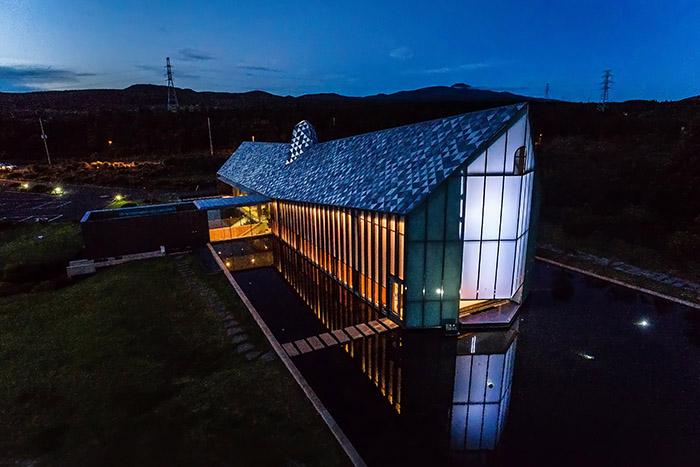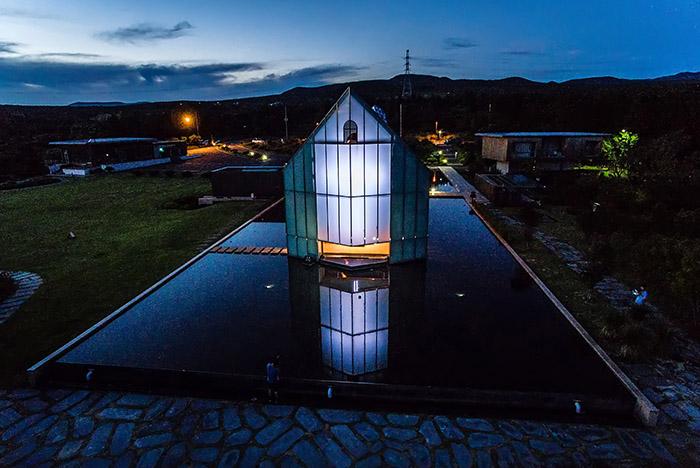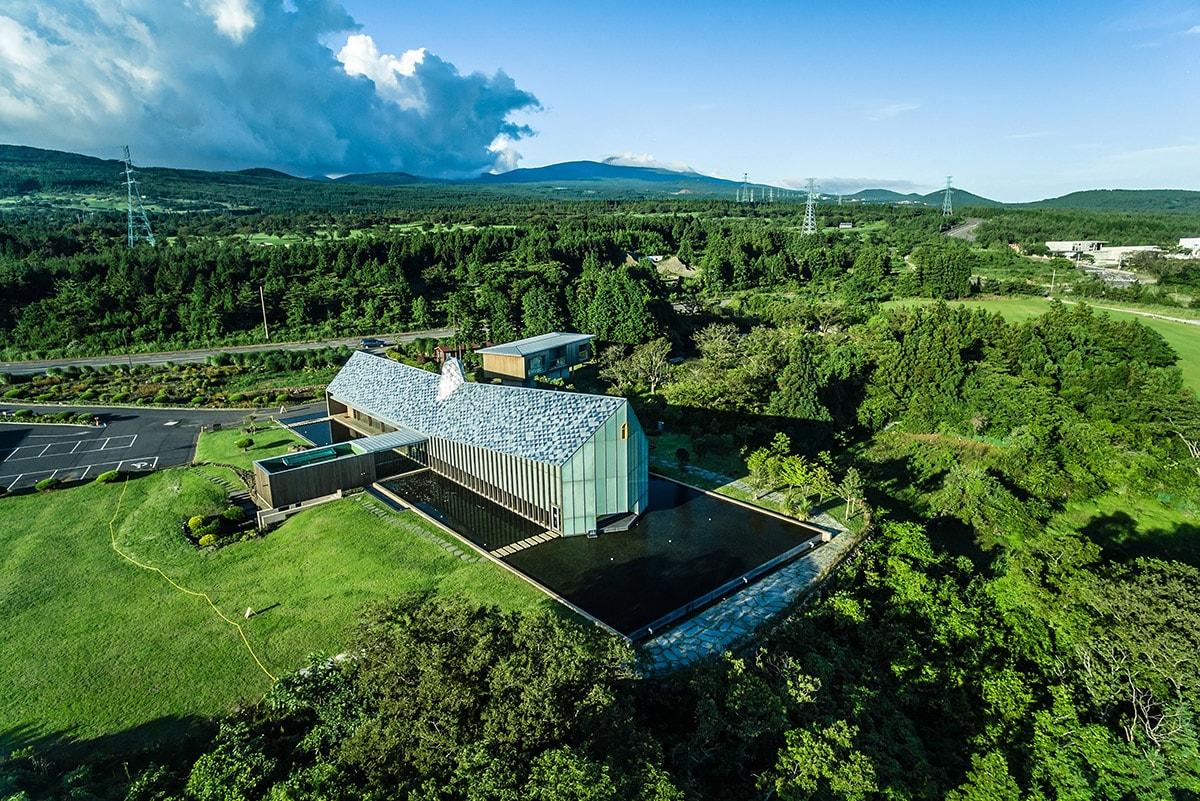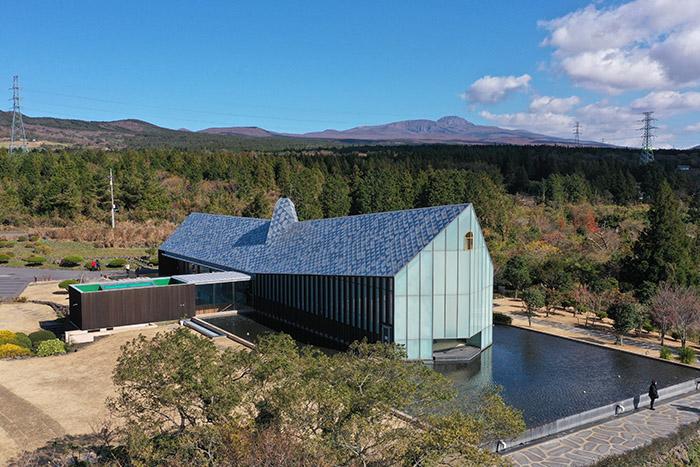Church flowing on water
Bangju Church
Itami Jun (Dong-ryong Yoo) | Republic of Korea


Located within Pinx Biotopia, Bangju Church was designed by Itami Jun (1937–2011). A resident at the townhouse in Pinx Biotopia wanted to build a church within the complex, so he purchased a site and asked Itami Jun to design a church. The architect thought of this church as an extension to the four art museums project he had previously designed—Water, Wind, Stone, (Two Hands Underground) Museum—and focused on designing a church that blended with the natural surroundings.


His initial idea was a boat floating on the water, and when he first visited this site situated on top of an oreum (a parasitic cone) 400m above sea level, he thought this church would be the closest to the sky. So in his design, he invested a lot of thought and time in the roof and how it should harmonize with the beautiful Jeju Island sky, which constantly changes colors throughout the day. That is why the church was called the “Church of the Sky” during its early stages of construction.

Created based on the architect’s early design concept, the church looks like “Noah’s Ark” floating on water and surrounded by the nature of Jeju. The church’s roof is adorned with triangular panels made of three different metals. During the day, they glisten in the sunlight with different colors. The surface of the water reflects the clouds in the sky, creating a mystical image of Noah’s Ark sailing in the air.

While inside the church, you will still feel as if outdoors due to the light and shadow created by the repetitive vertical wooden and glass panels. What’s more, when you look through the glass you can see the natural surroundings reflected on the surface of the water, which creates the illusion of being aboard a ship. The repeated wooden frames on the walls add to the reverent atmosphere.

TIP
Bonte Museum (www.bontemuseum.com), designed by Tadao Ando, is within walking distance from the church. The museum exhibits both traditional Korean craftwork and modern artwork.
TOURIST ATTRACTIONS
• Jungmun Resort
• Bonte Museum
• O’sulloc Tea Museum
• Water, Wind, Stone Museum
Address
113 Sallongnam-ro 762beon-gil, Andeok-myeon, Seogwipo-si, Jeju Island
Way
Taxi (40mins) from Jeju International Airport
Tel
064-794-0611
Admission
Free
Website
www.bangjuchurch.org
Time
Exterior: May–Sept 9:00–19:00; Oct–Apr 9:00–18:00 (Open all year round) /
Interior: 10:00–12:00; 14:00–17:00 (On Sundays from 15:00 to 17:00, only the chapel is open to the public.)
Building reflecting a patriot’s upright spirit
Ahn Jung Geun Memorial Museum
Yeong-hwan Lim & Sun-Hyun Kim | Republic of Korea

Ahn Jung-geun (1879–1910) is a renowned figure who sacrificed his life to fight for the independence of Korea from Japanese colonialism. The Ahn Jung Geun Memorial Museum was built on the site of the former Joseonsingung Shrine in 1970 (reconstructed in 2009) in honor of his noble and patriotic spirit. During the Japanese colonial era, the shrine was built as a symbol of Japan’s colonial rule over Korea. The museum is meaningful in that it removed traces of Japanese colonialism, which had taken over the nation’s religion and spirituality, and built a place of tribute to a national leader and independent activist.

Overall, the museum is a cluster of 12 rectangular pillar-like structures. The number 12 symbolizes the 12 heroes, including Ahn, who pledged to fight for their country’s independence from Japanese imperialism. They cut off the last joint of their fourth finger and wrote, “National Independence of Daehan (Korea)” on a national flag when creating a small death defying corps called “Donguidanjihoe.” The 12 translucent “pillars” representing each member of the group are covered in a double-layered U-shaped glass. This evenly translucent material allows sunlight to enter during the day, like traditional Korean windows made of wooden frames and mulberry paper, creating a gentle ambiance inside the building. At night, interior lights shine through the glass, highlighting the museum’s presence.
In order to enter the museum, you need to walk the long downward entryway to the underground level. The calm space adds to the reverent atmosphere of the museum. Upon entering the building, you will see an area with a large three-story void. The light that comes through the skylight shines on the statue of Ahn Jung-geun, creating a strong impression on visitors.

















![[A ZONE] Gangnam Food Spot](https://www.dgram.co.kr/wp-content/uploads/2020/09/A존-알래스카3-특성이미지_S-324x160.jpg)
![[A ZONE] Gangnam Life Style](https://www.dgram.co.kr/wp-content/uploads/2020/09/로우클래식1-특성이미지_S-324x160.jpg)




